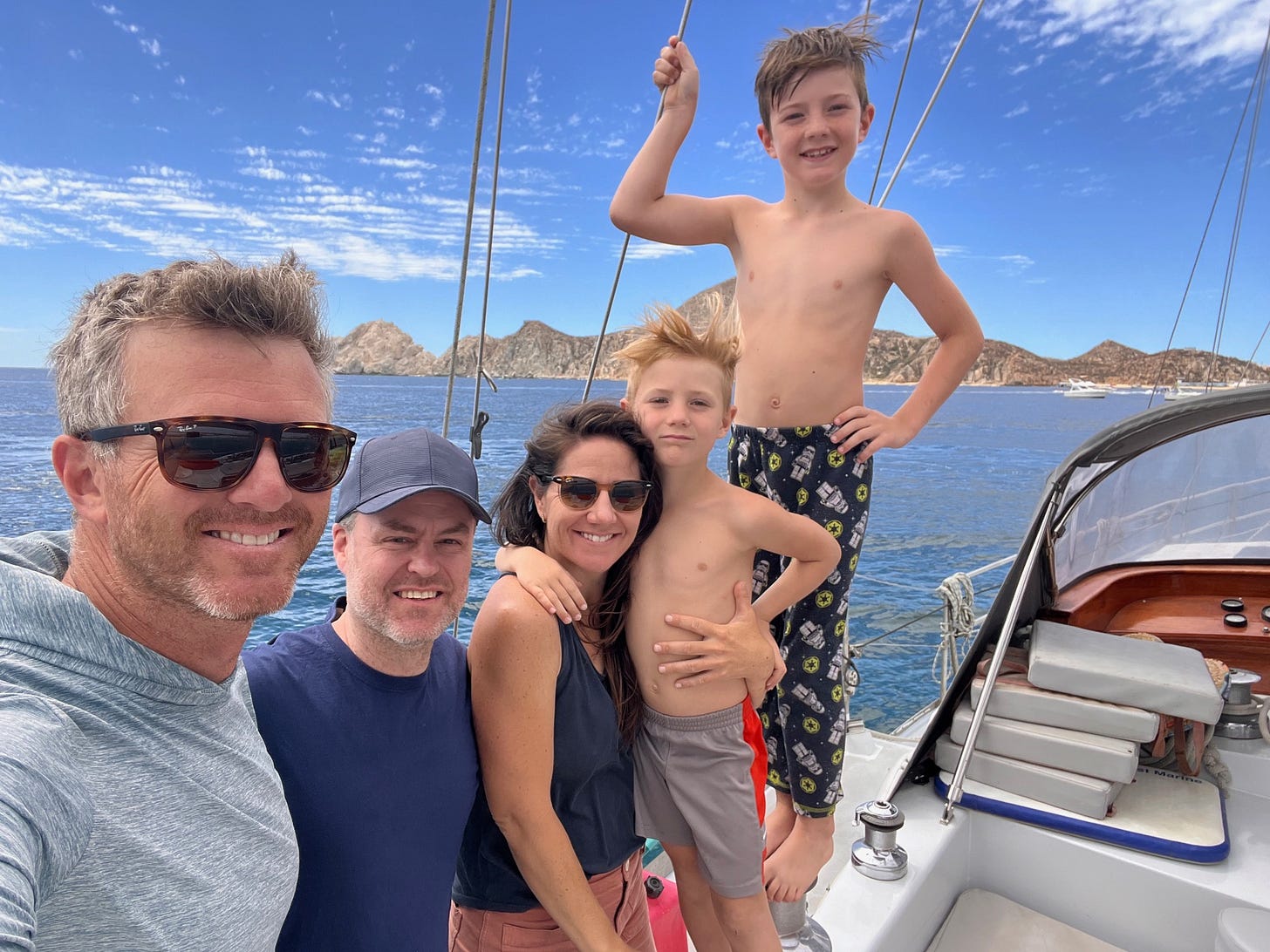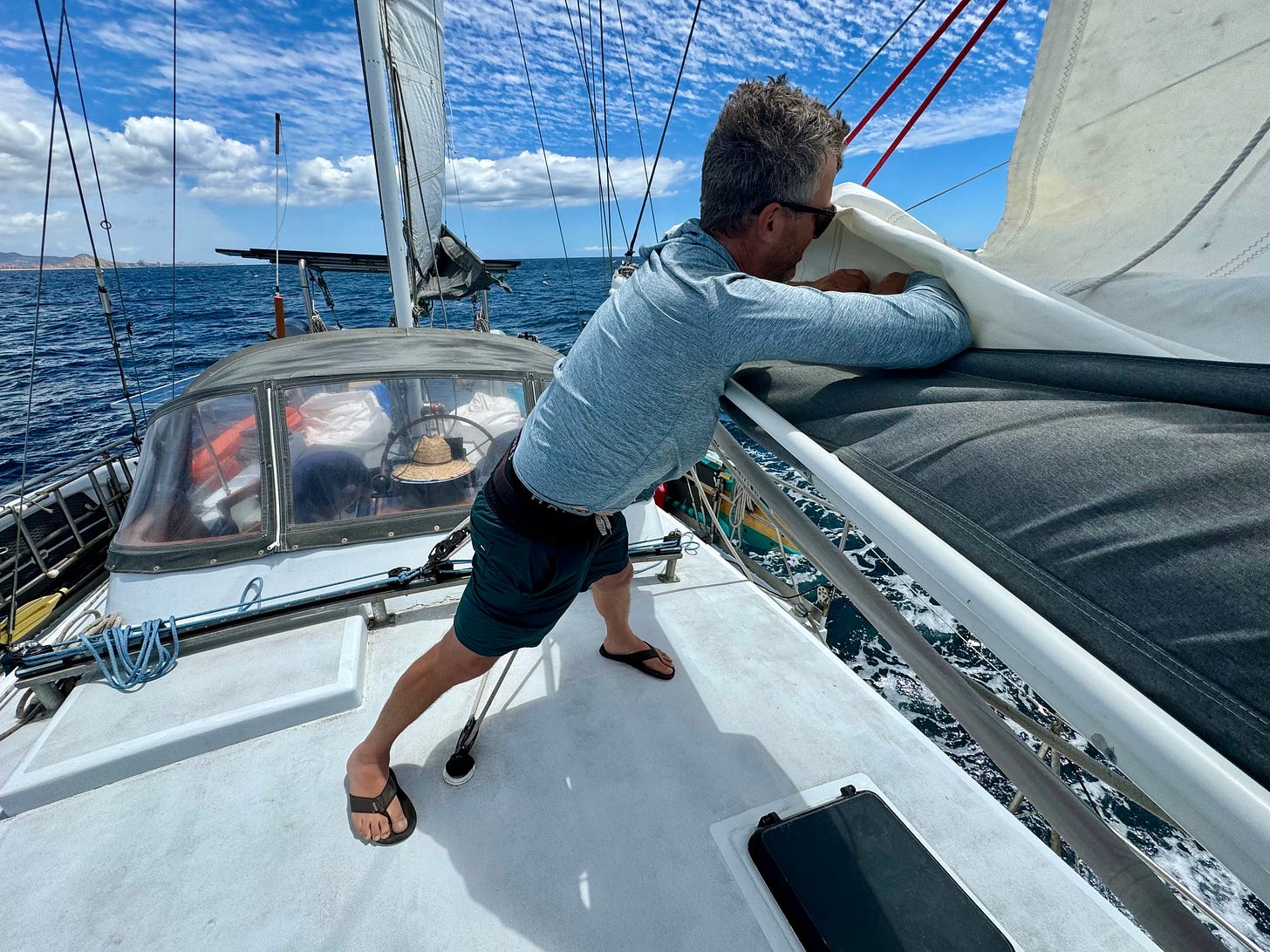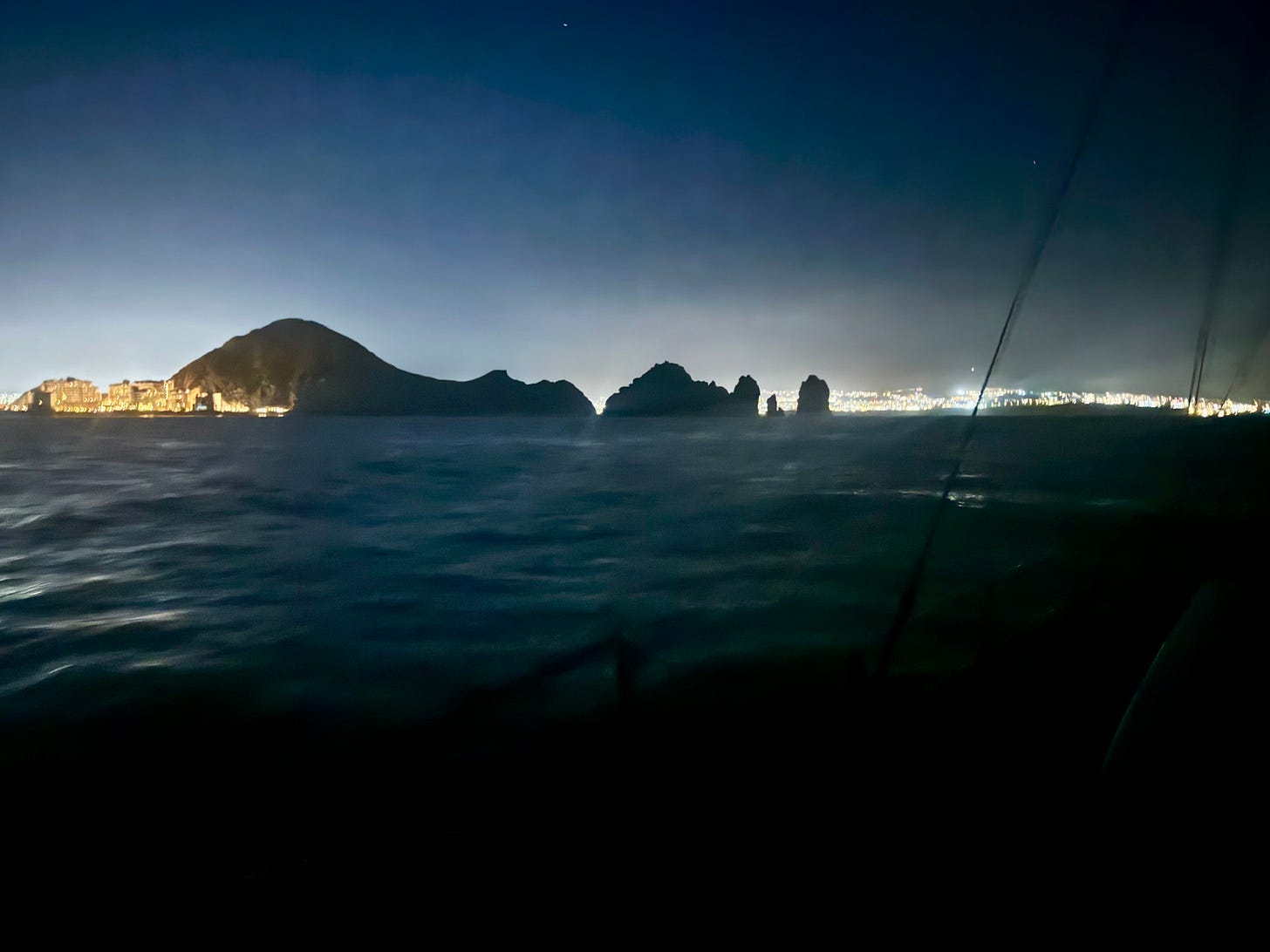Assessing and mitigating risk does not guarantee that things won’t go wrong—it merely ensures that whatever does go wrong will be unexpected. Take the stock market. When the public expects a market crash, the market usually doesn’t crash. The market prepares for a crash, which in turn mitigates the crash. Things go wrong when everything is going fine. Stock market crashes, like sailing disasters, are like the Spanish Inquisition: nobody expects them.
It was in the spirit of sound risk analysis that the good ship s/v Impossible set about preparing for its 20-day Pacific crossing with built-in known risks. Take our onboard desalination system, or watermaker, that turns sea water into drinking water using reverse osmosis. In the weeks leading up to our departure, the RO membrane began to fail, which we only discovered after filling our water tanks with 400 gallons of brackish water over the course of several tedious days offshore. Upon this discovery we emptied both tanks and skimped through our last days in Cabo San Lucas drinking jugs of bottled water. I installed our spare membrane, but we would need to be offshore before filling our tanks so as not to plug our filters with sediment from the tumultuous waters of the bay that had become thick with floating sand and reefer buds stirred up by bands of annoying JetSki tourists.
We would set off on a 20-day Pacific crossing with five people on board and essentially no potable drinking water. It was a known issue, the risk already mitigated. We had enough beer, milk, juice, coconut water, and canned food liquid to sustain ourselves for weeks in the unlikely event that we couldn’t make water once leaving the harbor. Worst case we could just turn back.
Then there’s electricity. In the days leading up to our departure we strained our house batteries by doing loads and loads of laundry to use up our semi-brackish water, and roasted several pounds of coffee. We carry an electric coffee roaster and a couple hundred pounds of raw coffee beans, allowing us to roast fresh coffee every week for the espresso machine. We are entering into this venture soft-bellied and not roughing it. We used more electricity than we could replenish with our solar panels during those final days, which meant that on departure day we had only 50% charge on our house battery bank. Risk accepted; we could go light on electricity usage in the first days or run the engine to charge with the alternator.
We rented a car and took several trips to the Costco, Walmart, and the Super Chedraui for provisions, filling our dinghy time and again with hundreds of pounds of food, which we stashed in every available cubby, bilge, cabinet, and closet. We wouldn’t see a grocery store for the next four months, so we stocked up on non-perishable staples to get us through, expecting to top up our fresh foods from small island markets in Polynesia, and fishing for our protein.
Unexpected hazards surfaced here and there, of course, as one can’t prepare for every unforeseeable risk. While unloading one dinghy load of provisions, a twenty-something frat-boy tourist riding a JetSki with his girlfriend on the back approached our boat from starboard. I watched curiously as he drove expressionless and determined directly toward us. Still driving, not stopping. These little bastards have no concept of courtesy, I thought. Hundreds of them swarmed the anchorage every day like mosquitoes, roosting us with their wakes as we tried to perform our daily tasks. It was clear from the dopey expression and lack of motor control that he was drunk or high and he wasn’t stopping, but before I could act he slammed straight into our boat. The pointy tip of the machine gouged straight through all of the new layers of epoxy, primer, and paint that had just been applied by the boatyard, exposing raw steel. I could almost see the rust forming as he sat there fumbling through his profuse stoner apology and I searched the very bowels of my soul for the self-control not to beat him to death with his own shoes right there on the spot.
First thing in the morning on April 1st we weighed anchor and motored around the cape, set our sails, and drifted silently out to sea under the power of the wind. Our watermaker quietly trickling fresh water into our empty tanks and the sun pushing electrons into our hungry battery bank. We were on our way—3,000 miles and twenty days were the only things standing between us and the Marquesas islands—our new life.
But the crash will get you when you least expect it.
We spent the first full day sailing through sloppy seas taking copious water over the bow. I discovered a small rip in the mainsail shortly after departure and managed to sew it up as we continued our forward progress; stitch, sail tape, on our way. As evening descended we caught a big eye Tuna, which I cleaned on the deck. As I cleaned it Sven interrupted me.
“Brad, what in the exact hell is that?”
I looked over his shoulder and saw a rocket shooting into the night sky—what we would later learn was the SpaceX Falcon 9 delivering 20 new satellites into the Starlink constellation.
Sheena took her first night watch and then, 20 hours and 100 miles into our journey, I took over for the midnight-to-three-AM shift. I adjusted the sails for the 20-knot winds on our port beam and happily hunkered down on the outdoor cockpit cushions to watch the night go by. I had moved the main boom’s traveler car up to windward, putting a slight twist in the sail to allow excess air to spill over the top rather than overpowering the sail. A conservative setup. A few minutes later I was shaken from my zen state by a loud crack. I turned my head to see the boom just behind me pointing oddly straight up in the air. It was the feeling you get when you compound fracture your arm and can’t quite understand why it’s folded over where there isn’t a joint.
I quickly unsheeted the main and allowed it to fall out of the wind. I ran downstairs and woke up Sven.
“Sven…” (zzzzz) “Sven!” (zzzzz) “Sven, the boom snapped!”
(Snort) “What the what?”
We ran outside and dropped the mainsail into its sail pack and pulled the boom into a secure position with the main sheet as the swell began to roll the boat from rail to rail without the stabilizing pressure of the mainsail. After securing everything we looked at each other in the dark.
“I guess we go back now,” he said. Obviously we would go back 110 miles rather than continuing 2,890 miles without a mainsail and then trying to repair the boom in a remote Pacific atoll, but the idea of turning back now was almost unbearable. I took the helm and after a couple of failed attempts was able to bring the boat about into the wind for the upwind return.
Upon aiming back into the wind we discovered that we had to point well south of Cabo to get back home due to the wind angle, which had changed by 15 degrees suddenly. I decided to start the engine to assist us in motor-sailing a bit closer to the wind so that we could go directly back without having to tack. By now the batteries were down to 26% from the heavy draw of the autopilot and the last 20 hours of making water.
I went down and turned the key but rather than rumbling to life, for the first time in the eight years we’ve owned the boat the engine made but a click. “You’ve got to be kidding me.” Click. Click. Click. Could we possibly have a dead starter battery? That should be impossible given how it’s wired up to be charged by the house bank. I checked it on our battery monitor: full state of charge. I temporarily jumped the house to the starter battery to use the lithium batteries to start it. Click. Click. Click.
My mind went immediately to the situation that led to our generator having been decommissioned and trashed: hydro lock. When sailing downwind we should close the exhaust valve so that ocean water can’t force its way back into the engine through the exhaust. I hadn’t closed the valve since we weren’t really downwinding, but was nevertheless convinced that the engine had sea water in the cylinders, preventing them from moving. Suddenly, with a broken boom and a hydro-locked engine, Polynesia was looking less and less in the cards this year. This could be major surgery and an engine rebuild.
With little battery and no engine we had no choice but to sail back without the mainsail while hand-steering without the autopilot. It is a sailboat after all, so sailing is a natural choice. But given the wind direction it looked like we would not be able to sail the 20+ hours directly back to Cabo; rather, we would have to sail south of the cape and toward the mainland for an additional day and then tack north, nearly tripling the return time. And hand steering meant that someone would always be glued to the helm watching the windex on top of the mast to ensure we were sailing as close to the wind as possible without getting in-irons, or stalling. Hand steering in big seas is exhausting—especially at night—and in this case we had 10-foot seas with relatively short periods, making an upwind slog very uncomfortable and very tiring.
We sailed this way for the next 16 hours. Checking the wind forecast over Starlink showed that a sizable area below the cape would be windless when we passed, and then we would be adrift without wind, bobbing in the waves awaiting a breeze for about an additional day before we could continue on our way.
Sven had mentioned that he thought it could be the starter causing the engine not to start. I had been transfixed on hydro lock: identical symptoms to the generator, I was absolutely sure. The following night after Sheena went to sleep I accompanied Sven on his watch. By starlight we discussed the symptoms and agreed that I should go down and try to crank the engine over by hand to see if the camshaft would budge. I did so, but couldn’t get it to move at all with my socket wrench and breaker bar. Looking like hydro lock so far. As a last ditch effort I decided to try the starter again to see if it would move a little. I fixed my eyes on the end of the shaft and turned the key. It very slightly budged before stopping. I did it again—slight movement. I turned the key and held it and the shaft tried to turn.
“Go down and bang on the solenoid with something,” he said. I did this and tried again, and lo and behold it slowly cranked and then fired up!
Sheena came bursting out of the bedroom while Sven and I pumped our fists in exhausted celebration. SHE LIVES!
Suddenly our batteries were being replenished by the life-giving teat of mother alternator. We switched the autopilot on and set a course closer to the wind, speeding ahead at seven knots. When the wind died, as expected, we dropped all sail and motored directly into the bay at Cabo San Lucas, dropping the anchor at 2:30 AM and crumpling into a kind of deep sleep that I like to call the “dead sailor.”
Two days after our departure for French Polynesia
we found ourselves right back where we started with a broken boom, broken spirits, and uncertainty whether we would be able to fix this before Sven had to go back to Sweden. Sheena and I began to discuss whether this thing was even possible this year with the window for cyclone season already creeping shut. Would we go back to Seattle and try again next year? What would we do with the boat? If we could get it fixed, how would we find a new crew to join us on such short notice?
This never came up in our risk analysis. We hadn’t thought about what to do in this situation. But in thinking back on our history of world travel we could recall lots of times when it looked like we had reached the end of our pathetic road and had to rely on logic and determination. Our transmission failure in Colombia and being stuck on the mountain farm for two months. The engine wiring harness melting down in Thailand and having to rewire it using a roll of monofilament wire from a small countryside hardware store. Being stranded in a tidal marsh on the Pakistani border. Being the subjects of an international search and rescue mission in the Laotian mountains. If we could get through all of that, we could get through this.
But first, sleep.











Wow … looking forward to hear where you are now… good luck guys !!
Thank heaven for the calm-and logic-under-pressure displayed by the adults on board!